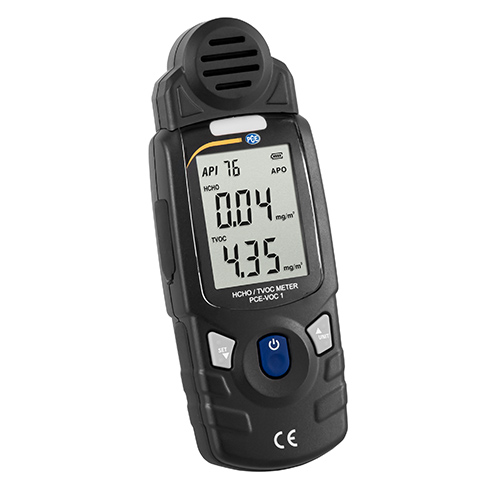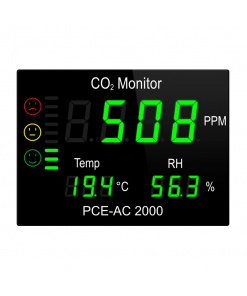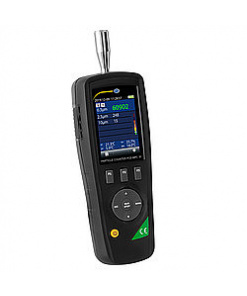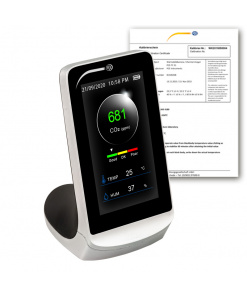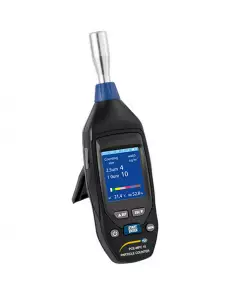Air Quality VOC Meter PCE-VOC 1
PCE-VOC 1
Availability : กรุณาติดต่อสอบถาม
PCE-VOC 1 Air Quality VOC Meter
Portable handheld volatile organic compound (VOC) and formaldehyde (HCHO) gas leak detector for indoor air quality (IAQ) monitoring
PCE-VOC 1 is a portable handheld volatile organic compound (VOC) and formaldehyde (HCHO) meter or gas leak detector for indoor air quality (IAQ) monitoring applications. This easy-to-use VOC meter is ideal for measuring total volatile organic compound (TVOC) and formaldehyde (HCHO) levels in homes, offices, factories, laboratories, hotels, schools and other indoor environments. The VOC meter’s long-lasting rechargeable lithium-polymer (LiPo) battery and included 9V power adapter/charger ensure uninterrupted IAQ monitoring.
Featuring a compact and lightweight yet heavy-duty design, the VOC meter displays units in parts per million (ppm) or milligrams per cubic meter (mg/m³). In addition to emitting an audible alarm, the device’s large, easy-to-read LCD screen turns red when a critical VOC or HCHO level is reached.
What are volatile organic compounds (VOCs)?
VOCs are airborne gaseous or vaporous substances of organic origin. Examples of VOCs include hydrocarbons, alcohols, aldehydes and organic chemicals.
Where do VOCs come from?
Many detergents, solvents, paints, varnishes, adhesives and other synthetically manufactured substances can produce VOCs. In addition, numerous naturally occurring organic compounds formed by biological processes such as plant metabolism, decay and degradation can create VOCs.
How do VOCs get into the air?
VOCs can become airborne through evaporation or emission. Evaporation sources can include household cleaning products, construction and building materials, and indoor furnishings, flooring and decor. Emission sources can include traffic exhaust, tobacco or cigarette smoke and industrial pollution. Even food preparation and human metabolism can be sources for airborne VOCs.
Less obvious is the proliferation of various impurities not firmly embedded in products. These impurities can be slowly released from the product’s surface into the air. This applies, for example, to residual solvents in plastics (monomers), auxiliaries such as plasticizers, solubilizers, antioxidants, stabilizers and catalysts used in the production process, as well as by-products such as fragrances, flame retardants and biocidal agents. VOCs called terpenes can be released from materials of natural origin, like wood. VOCs also can be formed during reactions between oxygen, ozone or water with natural ingredients in wood and vegetable oils.
What are the health effects of VOCs?
Usually, indoor VOC concentrations are low and present little risk to human health or safety. However, prolonged or excessive exposure to VOCs can lead to adverse health effects including headaches, dizziness, fatigue, nausea, liver and kidney damage, and cancer. Occupants worried about the presence of VOCs in homes, schools and businesses should seek advice from IAQ experts such as industrial hygienists and heating, ventilation and air conditioning (HVAC) professionals.
How can indoor VOC concentrations be reduced?
Consumers should choose low-emission products and materials. Environmentally friendly labeling such as the Blue Angel is a helpful purchasing aid. Construction materials successfully tested according to the AgBB scheme with a recognized Ecolabel provide assurance that the potential for VOC emissions is minimized. Regular testing, adjusting and balancing (TAB) of HVAC systems should be performed to alleviate VOC concentration through proper ventilation.
– Measures total volatile organic compound (TVOC) and formaldehyde (HCHO) levels
– Displays units in parts per million (ppm) or milligrams per cubic meter (mg/m³)
– Long-lasting rechargeable lithium-polymer (LiPo) battery
– Audible and visual alarms
– Large, easy-to-read LCD screen
– User-friendly three-button operation
– Compact and lightweight yet heavy-duty design
| Measuring range | |
| HCHO | 0.00… 5.00 ppm or mg/m³ |
| Resolution | 0.01 ppm or mg/m³ |
| Accuracy | ± 5% of measured value |
| Measuring range | |
| TVOC | 0.00… 9.99 ppm or mg/m³ |
| Resolution | 0.01 ppm or mg/m³ |
| Accuracy | ± 5% of measured value |
| Response time | < 2 seconds |
| Operating temperature | 32… 104 °F / 0… 40 °C |
| Storage temperature | 14… 140 °F / -10… 60 °C� |
| Power supply | 7.4 V / 1200 mAh LiPo battery |
| Power adapter/charger | 9 V / 1 A |
| Charging time | Approx. 2 hours |
| Weight | Approx. 1.3 lbs / 584 g |
| Dimensions | 6.5 x 2.4 x 1.0 in / 165 x 60 x 25 mm |
สินค้าที่เกี่ยวข้อง
Air Quality Meter
Air Quality Meter PCE-CMM 8-ICA incl. ISO Calibration Certificate
PCE-CMM 8-ICA
Air Quality Meter
PCE-AC 2000
Air Quality Meter
PCE-CMM 8
Air Quality Meter
PCE-RCM 15
Air Quality Meter
PCE-RCM 12
Air Quality Meter
PCE-MPC 30
Air Quality Meter
Air Quality Meter PCE-CMM 5-ICA incl. ISO Calibration Certificate
PCE-CMM 5-ICA
Air Quality Meter
PCE-MPC 10

